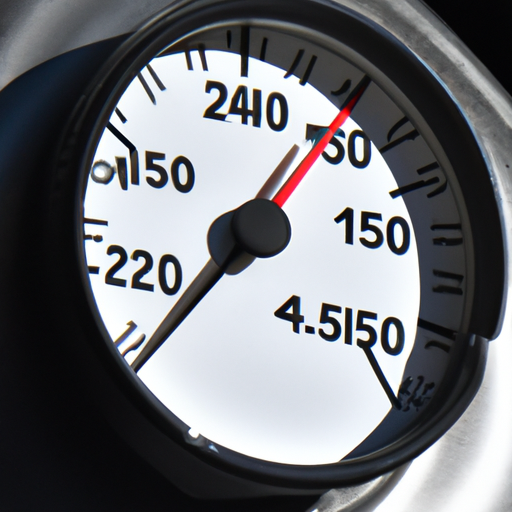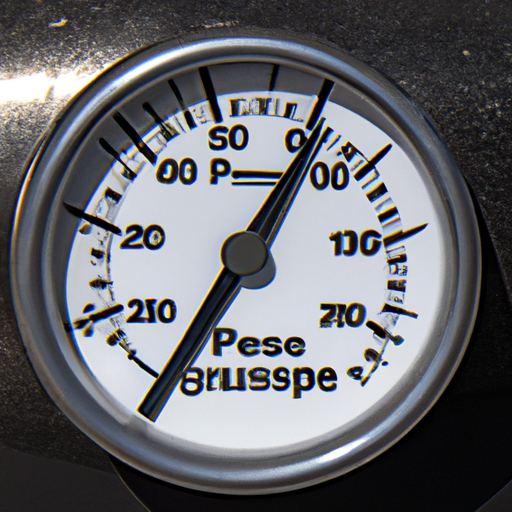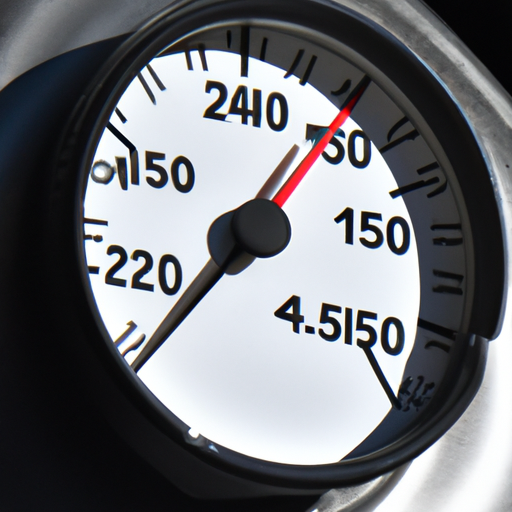Maintaining proper tire pressure is essential for optimal performance and safety while driving. But when it comes to your summer tires, how often should you be checking the tire pressure? Well, the answer may vary depending on various factors such as temperature, usage, and manufacturer recommendations. In this article, we will explore the importance of regular tire pressure checks for your summer tires and provide some guidelines to help you keep them in top shape. So, sit back, relax, and let’s get into it!

Importance of Regular Tire Pressure Checks
Ensuring Optimal Performance
Regular tire pressure checks are crucial for maintaining optimal performance of your vehicle. Properly inflated tires ensure a smooth and comfortable ride by providing the necessary traction and stability. When your tires are at the correct pressure, you can enjoy a more responsive handling and control, allowing you to maneuver your vehicle with ease. Neglecting tire pressure checks can lead to underinflated or overinflated tires, resulting in poor performance and an uncomfortable driving experience.
Improving Fuel Efficiency
Did you know that proper tire pressure plays a major role in fuel efficiency? When your tires are underinflated, they create more rolling resistance, which means your engine has to work harder and burn more fuel to move the vehicle. On the other hand, overinflated tires can also lead to decreased fuel efficiency due to decreased traction and increased wear on the tires. By regularly checking and maintaining the correct tire pressure, you can significantly improve your vehicle’s fuel economy, saving you money at the gas pump in the long run.
Enhancing Safety on the Road
Ensuring that your tires are properly inflated is essential for your safety and the safety of others on the road. Underinflated tires can lead to decreased traction, especially in wet or slippery conditions, making it difficult to stop or maneuver your vehicle effectively. On the other hand, overinflated tires can result in reduced contact between the tires and the road, leading to a loss of control and increased risk of accidents. By regularly checking your tire pressure, you can enhance the overall safety of your vehicle, minimizing the chances of accidents caused by tire-related issues.
Factors Affecting Tire Pressure
Temperature Changes
One of the main factors that affect tire pressure is changes in temperature. As the temperature fluctuates, the air inside your tires expands and contracts. In hot weather, the air expands, leading to an increase in tire pressure. Conversely, in cold weather, the air contracts, causing a decrease in tire pressure. It is important to note that temperature changes can occur over a short period of time, so it’s crucial to regularly check your tire pressure, especially during the changing seasons.
Time Since Last Check
The longer it has been since the last tire pressure check, the more likely it is that the pressure has changed. Even if your tires appear visually fine, it is still important to check the pressure regularly. Tire pressure can naturally decrease over time due to various factors, such as small leaks or normal air loss. Therefore, it is recommended to include tire pressure checks as part of your routine vehicle maintenance.
Driving Conditions
Driving conditions can also have an impact on tire pressure. Some driving conditions, such as prolonged periods of high-speed driving or driving on rough terrain, can increase the likelihood of tire pressure changes. Additionally, if you frequently encounter potholes or curbs while driving, it is advisable to check your tire pressure more frequently, as these impacts can potentially cause damage and affect the tire pressure.
Recommended Frequency for Checking Tire Pressure
Manufacturer Guidelines
The manufacturer of your vehicle is the best source of specific guidelines and recommendations for checking tire pressure. Every vehicle may have slightly different requirements, so it is essential to consult the owner’s manual or contact the manufacturer for the recommended frequency of tire pressure checks. Following the manufacturer’s guidelines will help you maintain the optimal performance and safety of your vehicle.
Monthly Checks
As a general rule of thumb, it is recommended to check your tire pressure at least once a month. This regular monthly check ensures that you catch any potential issues early on and allows you to maintain the correct pressure for optimal performance. It is important to remember that the tire pressure should be checked when the tires are cold, as driving even a short distance can heat up the tires and increase the pressure, leading to inaccurate readings.
Before Long Trips
Before embarking on a long trip, it is crucial to check the tire pressure. Long trips often involve extended periods of driving, which can put added stress on the tires. By ensuring that your tires are at the correct pressure before your journey, you can minimize the risk of tire-related issues on the road and enjoy a safe and comfortable trip.
After Drastic Temperature Changes
If there are drastic temperature changes in your area, it is recommended to check your tire pressure more frequently. As mentioned earlier, temperature fluctuations can cause significant changes in tire pressure. By checking your tire pressure after such changes, you can adjust the pressure accordingly and maintain optimal performance and safety.
After Hitting Potholes or Curbs
If you happen to hit potholes or curbs while driving, it is advisable to check your tire pressure as soon as possible. These impacts can potentially cause damage to the tires, leading to a loss of air pressure. By checking the tire pressure promptly, you can detect any issues and address them appropriately, minimizing the risk of further damage or accidents.
Signs of Incorrect Tire Pressure
Abnormal Tire Wear
One of the telltale signs of incorrect tire pressure is abnormal tire wear. Underinflated tires tend to wear more on the sides, while overinflated tires wear more in the center. This uneven wear pattern not only affects the performance and lifespan of your tires but can also compromise your safety on the road. Regularly inspecting your tires for signs of abnormal wear is essential to catch any tire pressure issues early on.
Difficulty in Handling and Control
Driving with incorrect tire pressure can negatively impact your vehicle’s handling and control. Underinflated tires can make your steering feel heavy and unresponsive, while overinflated tires can make your vehicle feel more sensitive and prone to oversteering. If you notice any difficulty in handling your vehicle, it is important to check your tire pressure as a potential cause. By maintaining the correct tire pressure, you can ensure a smooth and controlled driving experience.
Increased Fuel Consumption
If your vehicle’s fuel consumption has suddenly increased, it could be a sign of incorrect tire pressure. Underinflated tires create more rolling resistance, requiring your engine to work harder and burn more fuel to propel the vehicle. By regularly checking and maintaining the correct tire pressure, you can enjoy improved fuel efficiency and save money on fuel expenses.

How to Check Tire Pressure
Gather Necessary Equipment
To check your tire pressure, you will need a few key items: a tire pressure gauge, a pen and paper for recording the readings, and a reliable source of compressed air to adjust the pressure if needed. It’s important to use a quality tire pressure gauge for accurate readings.
Locate the Recommended Pressure
The recommended tire pressure can usually be found in your vehicle’s owner’s manual or on a sticker located on the driver’s side door jamb or fuel filler door. It is crucial to use the recommended tire pressure for your specific vehicle, as different vehicles may have different requirements.
Use a Reliable Tire Pressure Gauge
Place the tire pressure gauge onto the valve stem of the tire. Press it firmly and wait for the reading to stabilize. Ensure that the gauge is aligned straight with the valve stem to prevent air from escaping and to get an accurate reading.
Remove the Valve Cap
Before checking the tire pressure, remove the valve cap from the valve stem. Keep the valve cap in a safe place to prevent it from getting lost. The valve cap helps to keep dust and debris out of the valve stem, maintaining a proper seal.
Press the Gauge onto the Valve Stem
Press the tire pressure gauge onto the valve stem firmly and hold it in place until the reading on the gauge stabilizes. Make sure the gauge is tightly sealed against the valve stem to get an accurate pressure reading.
Check the Pressure Readout
Once the reading on the gauge is stable, take note of the pressure displayed. Compare it to the recommended pressure for your vehicle. If the pressure is within the recommended range, you are good to go. If not, you will need to adjust the pressure accordingly.
Adjust the Pressure if Needed
If the tire pressure is too high, you will need to release some air using a tire pressure release valve or by gently pressing down on the valve stem with the gauge. If the tire pressure is too low, you will need to add air using a reliable source of compressed air. Recheck the pressure after adjusting to ensure it is within the recommended range.
Replace the Valve Cap
After checking and adjusting the tire pressure, securely replace the valve cap onto the valve stem. This helps to maintain a proper seal and prevent any air leaks or debris from entering the valve stem.
Perform the Same Process on All Tires
Repeat the same process for all the tires on your vehicle, including the spare tire if applicable. Each tire may have different pressure requirements, so it is important to check and adjust them individually.
Tips for Maintaining Proper Tire Pressure
Keep a Tire Pressure Log
Maintaining a tire pressure log can help you track the changes in tire pressure over time. By recording the dates and pressure readings, you can easily identify any patterns or issues that may arise. This log can also serve as a reminder for when the next tire pressure check is due.
Regularly Inspect Tires for Visible Damage
Aside from checking the tire pressure, it is important to visually inspect your tires for any visible damage. Look for signs of cuts, bulges, or uneven wear. If you notice any abnormalities, it is recommended to have your tires inspected by a professional to ensure your safety on the road.
Avoid Overinflating or Underinflating Tires
Maintaining the proper tire pressure is crucial for optimal performance and safety. Avoid overinflating or underinflating your tires, as both can lead to various issues. Overinflated tires may result in reduced grip and handling, while underinflated tires can negatively affect fuel efficiency and increase the risk of tire blowouts. Adhere to the manufacturer’s recommended tire pressure for the best results.
Check the Spare Tire
Don’t forget to include the spare tire in your tire pressure checks. The spare tire is often overlooked, but it is equally important to ensure it is properly inflated in case of emergencies. A flat spare tire will be of no use when you need it the most, so make it a habit to include the spare tire in your regular maintenance routine.
Seek Professional Assistance if Necessary
If you are unsure about checking your tire pressure or suspect there may be underlying issues, it is recommended to seek professional assistance. Tire specialists or mechanics have the necessary knowledge and tools to accurately check and address any tire pressure issues. They can also provide advice and recommendations tailored to your specific vehicle and driving habits.

Importance of Proper Tire Inflation
Evenly Distributes Vehicle Load
Properly inflating your tires ensures that the weight of your vehicle is evenly distributed across all four tires. When the tire pressure is correct, each tire is able to support its share of the vehicle’s weight, preventing excessive wear on certain areas of the tire. This even weight distribution not only prolongs the lifespan of your tires but also contributes to a smoother and more comfortable ride.
Reduces Risk of Tire Blowouts
Underinflated tires are more prone to overheating, which can lead to tire blowouts. When the tire pressure is too low, the sidewalls of the tire flex excessively, generating heat that can cause tire failure. By maintaining the proper tire inflation, you greatly reduce the risk of blowouts, ensuring a safer driving experience for you and your passengers.
Prolongs Tire Lifespan
Proper tire inflation is key to prolonging the lifespan of your tires. Overinflated tires can wear out the center of the tread prematurely, while underinflated tires can wear out the edges. Both scenarios lead to decreased tire lifespan and the need for more frequent tire replacements. By consistently checking and maintaining the correct tire pressure, you can extend the lifespan of your tires, saving you time and money in the long run.
Effects of Incorrect Tire Pressure on Summer Tires
Reduced Traction and Handling
Summer tires are specifically designed to provide optimal traction and handling in dry and warm conditions. However, incorrect tire pressure can significantly affect their performance. Underinflated summer tires may have reduced traction, making it harder to accelerate, brake, and turn. Overinflated summer tires, on the other hand, can result in decreased contact with the road, leading to compromised handling and control. By regularly checking and maintaining the correct tire pressure for your summer tires, you can ensure maximum grip and maneuverability, enhancing your driving experience.
Increased Risk of Hydroplaning
Summer tires are designed to disperse water efficiently, reducing the risk of hydroplaning on wet roads. However, incorrect tire pressure can diminish their ability to channel water effectively, increasing the chances of hydroplaning. Properly inflated summer tires have a larger contact patch with the road, allowing them to channel water away more efficiently, enhancing grip and reducing the risk of hydroplaning.
Accelerated Wear and Tear
Incorrect tire pressure can lead to accelerated wear and tear on summer tires. Underinflated tires tend to wear more on the sides, while overinflated tires wear more in the center. Both scenarios result in uneven wear, reducing the overall lifespan of your summer tires. By maintaining the recommended tire pressure, you can ensure even wear across the tire surface, maximizing their longevity.
Diminished Fuel Efficiency
Summer tires are often designed to provide low rolling resistance, contributing to improved fuel efficiency. However, when the tire pressure is incorrect, fuel efficiency can be compromised. Underinflated summer tires create more rolling resistance, requiring the engine to work harder and burn more fuel. Overinflated summer tires can also lead to decreased fuel efficiency due to decreased grip and increased wear. By keeping your summer tires properly inflated, you can enjoy optimal fuel economy, saving you money in the long run.

Common Misconceptions About Tire Pressure Checks
Only Important in Extreme Temperatures
While tire pressure checks are indeed crucial in extreme temperatures, they should not be limited to those conditions. Tire pressure is affected by various factors, as discussed earlier, and can change over time. Therefore, regular tire pressure checks are necessary regardless of the temperature outside. By staying proactive and checking your tire pressure regularly, you can avoid potential issues and ensure optimal performance throughout the year.
Visual Inspection is Sufficient
While a visual inspection of your tires is important, it is not sufficient to determine the tire pressure accurately. Tire pressure cannot be accurately judged by appearance alone. Even if the tires appear fine visually, they may still be overinflated or underinflated. A proper tire pressure gauge is necessary to obtain accurate readings. Incorporating regular tire pressure checks alongside visual inspections is the best approach to ensure your tires are in the best possible condition.
Gas Station Air Pumps Provide Accurate Readings
While gas station air pumps can be convenient for inflating your tires, they may not always provide the most accurate tire pressure readings. These pumps are often used by multiple vehicles and can become less accurate over time. Investing in a reliable tire pressure gauge allows you to obtain more precise readings and make adjustments as needed. It is worth having a quality tire pressure gauge as part of your vehicle maintenance toolkit.
Conclusion
Regular tire pressure checks are of utmost importance for maintaining the optimal performance, safety, and fuel efficiency of your vehicle. Ensuring that your tires are properly inflated enhances your overall driving experience and prolongs the lifespan of your tires. By following the recommended frequency for tire pressure checks and staying mindful of environmental and driving factors, you can enjoy a smooth and comfortable ride while minimizing the risk of tire-related issues on the road. Prioritize regular tire pressure checks, maintain proper inflation, and enjoy the benefits of optimal performance and safety for years to come.


